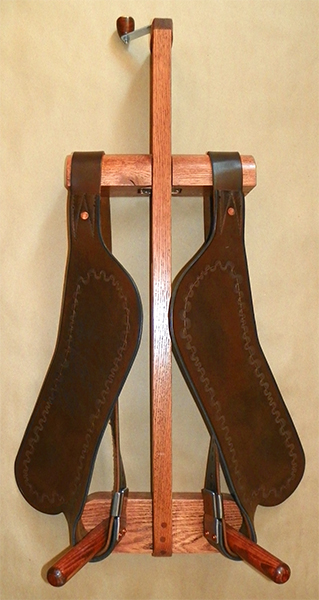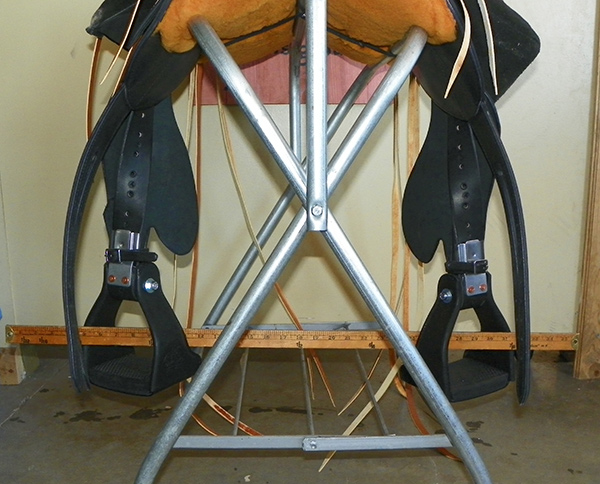Your new saddle has arrived and so you hurry out to your horse to get your first ride in. As you swing your leg over the saddle and settle in, that heavenly comfort you expected doesn’t seem to be all there. As your horse takes his first few steps they are accompanied by all sorts of squeaks and creaks. So what’s the problem? Well — your saddle just isn’t broken in yet.
While we have heard of a rider taking a brand new Synergist saddle out of the box and heading out immediately to a 50 mile endurance ride and everything working out great, that’s probably not the best way to go about breaking in your new saddle. The first few rides should be relatively short ones. A couple of hours at a time at first and gradually lengthen the duration of your rides. The leather skirting and the sheepskin need time to mold to your horse’s back. The seat needs time to mold to your butt. Think of a brand new set of heavy leather hiking boots. You wouldn’t want to go on a 30 mile hike with brand new boots right out of the box. Check your cinch often with a new saddle. As the underside starts to conform to your horse it will settle and the cinch will tend to loosen a bit.
When you take your new saddle to your horse the first time, some horses might act as if they have never seen a saddle at all before. It smells different, it looks different, and it’s going to feel different to your horse. That’s why it’s a good idea to saddle up your horse and then either lunge them for a few minutes or run them around a round pen to see how they react. Because of the tanning process for the leather and sheepskin, a new saddle doesn’t smell like a broken in saddle. It doesn’t feel like a broken in saddle. It’s more rigid and stiff and is going to make a little noise during the break in process. To break in a new saddle you are going to need some oil, some time in the saddle and your butt.
As with most things in the horse world, ask a question and you’re probably going to be quickly overwhelmed with all of the diverse advise you’ll hear. While there is a lot of differing views out there regarding saddle soaps, conditioners and oils, three things are pretty much agreed upon. Your saddle needs to be cleaned. It needs to be conditioned. And it needs to be oiled periodically.
Ideally, you should wipe your tack down with a damp cloth after each ride. The deal here is to be sparing with the water. Use a soft sponge or cloth (an old wash cloth works great), and just enough water to remove the dirt and sweat – don’t saturate the leather. Sweat is an enemy of leather. It tends to suck the moisture right out. If you start to see signs of dry leather follow up with a thin coat of oil. We use “pure” neatsfoot oil. Stay away from neatsfoot oil labeled with the word “compound”.
There are a lot of leather creams and conditioners on the market. Everybody has a favorite go to product. If you want to try a different conditioner or oil on your saddle, a good idea is to find a small place on the underside of the saddle to see how the product reacts with your leather. Different tanning processes with different conditioners and oils will have different results. A lot of products will tend to darken the leather. If that’s what you’re going for, then great. If not, it’s best to experiment in an area that is not readily seen.
Conditioning the leather should only be done periodically depending on the amount of use and climate that the saddle is exposed to. Over-conditioning will not make the leather stronger or better. There is only so much oil that a piece of leather can absorb. Too much oil can cause the leather to become so soft that the fibers start to detach from each other. This makes the leather weak and unsafe.

 We wet form and turn the fenders at the shop in a stretcher before they go on the saddle. You can help keep the turn in the stirrups by running some kind of stick (we use a yardstick) through the stirrups when you store the saddle between uses.
We wet form and turn the fenders at the shop in a stretcher before they go on the saddle. You can help keep the turn in the stirrups by running some kind of stick (we use a yardstick) through the stirrups when you store the saddle between uses.
After the initial break in period you should only oil when the leather starts to dry out. Be sure to pull the stirrup leathers part way down out from under the seat jockey so you can oil the straps where they bend around the bars. Most people forget to do this and this is an area that needs to be supple. Don’t pull the leathers all the way out of the tree because it can be very difficult to put them back in place.
How often should all of this be done? If you ride daily, in addition to wiping off the saddle daily with a damp cloth, it should be thoroughly cleaned every 6 to 8 weeks in an area with average humidity. More often if it is very dry. If you only ride a couple of hours a week, the leather treatments might only need to be done 2 or 3 times a year.
If your saddle becomes extremely wet (heavy rain, been through a deep water crossing) the cleaning and oiling procedure should begin immediately. For cleaning a really dirt and sweat covered saddle we will mix a capful of Murphy’s Oil Soap with a couple of quarts of water to really cut through the grime.
A well-built saddle that is cared for consistently will outlast many horses. It may even outlast the rider to become a treasured heirloom appreciated by the next generation or two.

Comments 4
Thank you Dave for this information. I did know the saddle needs cleaning in order to keep it in good condition, I did not know this about conditioning the saddle more often than 1 time a yr and that would be winter months, pulling the stirrup leathers down. I will start this and KNOW the SQUEAKS and CREAKS are going to go away. Maybe sooner. :>)
Judy
i have also known to be able to put a large amount of oil on it, mainly on a hot summer day. they sit on something such as a sawhorse or saddle rack and sit it in the sun!
Author
That’s an excellent tip. In the shop when we oil the leather on a new saddle, we heat the oil up in the microwave first so the oil to soaks in better.
Thanks for all the great information and the fabulous customer service! In this day and age it is so great to find folks that do what they say in a timely manner. I look forward to many years with this beautiful saddle!